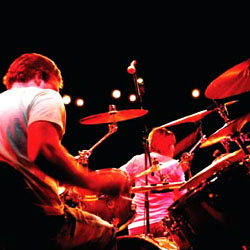Years ago, drum sounds were created with a narrow, well-defined selection of standard microphones and console EQ, plus outboard gates, reverbs and a few compressors, and then spending an inordinate amount of time adjusting it all while each drum was hit repeatedly.
In the recording studio, this can take weeks, but for live sound it’s compressed into a day at the tour’s beginning, and no more than an hour a day while on the road.
Digital consoles have changed the live sound work flow and their instant recallability forces the drum sound check to fit into whatever time is allowed, sometimes no more than a quick line check.
Here are some strategies to improve the sound of the drums using the tools at hand for modern engineers.
My Mics or Yours?
When it comes to mic’ing drums there are two extremes: using microphones provided by the venue or local sound vendor, or artist engineers bringing their own.
There’s a familiar set of standard drum mics, guaranteeing that if you specify them, they’ll be provided at almost any gig.
Common inventory includes Shure Beta52 and Beta91 for kick drum, SM 57 for snare, Beta98 for toms, and SM 81 condensers for cymbals, and KSM32 a popular overhead upgrade.
Stock mic choices allow experienced engineers to quickly adjust, providing predictable results that are easily duplicated on various analog and digital desks. Locally provided mics also allow the band’s crew to walk away from the stage after the show without collecting them.
Many prefer to bring their own mics because it provides the highest level of consistency while allowing alternate choices. When traveling with an entire drum set, it’s mics are a minor accessory, allowing the engineer to choose the very best mic for each chore.

Manufacturers also provide drum “packs,” with a selection tailored to typical drum kits in a convenient case and at a savings over purchasing them individually.
When using rental drums, house mics are often good enough, but the blended approach allows the engineer to bring just a few “artist supplied” mics while employing standard selections for everything else. A couple of mics can be quickly struck at the end of each show and are easily carried on the road in the back of a rack or in a briefcase.
The goal for special application mics has always been the best sound, but today a further aim for kick drum mics is to require no EQ. Standards like the Sennheiser MD 421, Electro-Voice RE 20, Audix D12 and beyerdynamic M 88 are all great mics, but often need to be contoured for kick.
Today the EV RE 320, AKG D 112, Shure Beta52 and Audix D6 all have scooped out mids, pronounced lows and enhanced highs, designed for a contoured response that requires no EQ.




















